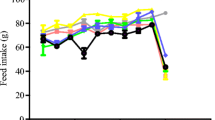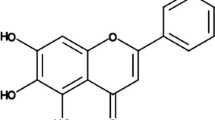Abstract
Myocardial infarction (MI∥ was produced in rats with 85, 200 and 300 mg/kg of isoproterenol (ISO) administered subcutaneously (sc) twice at an interval of 24 h. Shift in antioxidant parameters, lactate dehydrogenase (LDH) together with morphological and histopathological changes were investigated. Two hundred mg/kg ISO dose was selected for the present study as this dose offered significant alteration in biochemical parameters along with moderate necrosis in heart. Effect of pre‐ and co‐treatment of hydroalcoholic extract of Ocimum sanctum (Os) at different doses (25, 50, 75, 100, 200 and 400 mg/kg) was investigated against ISO (200 mg/kg) induced myocardial infarction in rats. Modulation of various biochemical parameters and membrane integrity was studied. Os at the dose of 25, 50, 75 and 100 mg/kg reduced significantly glutathione (GSH), superoxide dismutase (SOD) and LDH levels. It also inhibited the lipid peroxidation as observed by the reduced thiobarbituric acid reactive substances (TBARS) levels. In the present study Os at the dose of 50 mg/kg was found to demonstrate maximum cardioprotective effect. Above results were further confirmed by histopathological findings. Thus from the present study it is concluded that Os may be of therapeutic and prophylactic value in the treatment of MI.
Similar content being viewed by others
References
Maxwell SR: Prospects for the use of antioxidant therapies. Drugs 49: 345–361, 1995
Halliwell B: Drug antioxidant effects. A basis for drug selection? Drugs 42: 549–605, 1991
Rona G, Chappel CI, Balazs T, Gaudry R: An infarct like myocardial lesion and other toxic manifestations produced by isoproterenol in the rat. Arch Pathol 76: 443–445, 1959
Singal PK, Kapur N, Dhillon KS, Beamish RE, Dhalla NS: Role of free radicals in catecholamine induced cardiomyopathy. Can J Physiol Pharmacol 60: 1390–1397, 1981
Nirmala C, Puvanakrishnan R: Protective role of curcumin against isoproterenol induced myocardial infarction in rats. Mol Cell Biochem 159: 85–93, 1996
Dhar ML, Dhar MM, Dhawan BN, Mehrotra BN, Ray C: Screening of Indian plants for biological activity: Part I. Ind J Exp Biol 6: 232–247, 1968
Agarwal P, Rai V, Singh RB: Randomised placebo controlled, single blind trial of holy basil leaves in patients with non-insulin dependent diabetes mellitus. Int J Clin Pharmacol Ther 34: 406–409, 1996
Breckhman II, Dardymov IV: New substances of plant origin, which increase nonspecific resistance. Ann Rev Pharmacol 9: 419–430, 1969
Mediratta PK, Dewan V, Bhattacharya SK, Gupta VS, Maiti PC, Sen P: Effect of Ocimum sanctum Linn. on humoral responses. Ind J Med Res 87: 384–386, 1988
Balanehru S, Nagarajan B: Protective effect of olealonic acid and urosolic acid against lipid peroxidation. Biochem Int 24: 981–990, 1991
Devi PU, Ganasoundari A: Radioprotective effect of leaf extract of Indian medicinal plant Ocimum sanctum. Indian J Exp Biol 33: 205–208, 1995
Singh S, Majumdar DK: Evaluation of anti-inflammatory activity of fatty acids of Ocimum sanctum fixed oil. Indian J Exp Biol 35: 380–383, 1997
Lie JT, Pairolero PC, Holley KE: Macroscopic enzyme mapping verification of large, homogenous, experimental myocardial infarcts of predictable size and location in dogs. J Thorac Cardiovasc Surg 69: 599–605, 1975
Cabaud PG, Wroblewski F: Colorimetric measurement of lactic dehydrogenase activity of body fluids. Am J Clin Path 30: 234–236, 1958
Ellman GL: Tissue sulfhydryl groups. Arch Biochem Biophys 82: 70–77, 1959
McCord JM, Fridovich I: Superoxide dismutase: An enzyme function for erythrocuprein (hemocuprein). J Biol Chem 244: 6049–6055, 1969
Ohkawa H, Ohishi N, Yagi K: Assay of lipid peroxide in animal tissue by thiobarbituric acid reaction. Anal Biochem 95: 351–358, 1979
Lowry OH, Rosebrough NJ, Fara AL, Randall RJ: Protein measurement with the Folin-phenol reagent. J Biol Chem 193: 265–275, 1951
Baroldi G: Myocardial necrosis: The need for definition. J Mol Cell Cardiol 6: 401–402, 1974
Milei J, Nunez RG, Rapaport M: Pathogenesis of isoproterenol induced myocardial lesions: Its relation to human coagulative myocytolysis. Cardiology 63: 139–157, 1978
Rona G: Catecholamine cardiotoxicity. J Mol Cell Cardiol 17: 291–306, 1985
Bhagat B, Sullivan JM, Fischer VM, Nadel EM, Dhalla NS: cAMP activity and isoproterenol induced myocardial injury in rats. Recent Adv Stud Cardiac Struct Metab 12: 465–470, 1978
Dhalla NS, Ziegelhoffer A, Singal PK, Panagia V, Dhillon KS: Subcellular changes during cardiac hypertrophy and heart failure due to bacterial endocarditis. Basic Res Cardiol 75: 81–91, 1980
Fleckenstein A, Janke J, Doering HJ, Leder O: Myocardial fiber necrosis due to intracellular Ca overload: A new principle in cardiac pathophysiology. Recent Adv Stud Cardiac Struct Metab 4: 563–580, 1974
Yates JC, Dhalla NS: Induction of necrosis and failure in the isolated perfused rat heart with oxidized isoproterenol. J Mol Cell Cardiol 7: 807–816, 1975
Beamish RE, Dhillon KS, Singal PK, Dhalla NS: Protective effect of sulphinpyrazone against catecholamine metabolite adrenochrome-induced arrhythmias. Am Heart J 102: 149–152, 1981
Yates JC, Beamish RE, Dhalla NS: Ventricular dysfunction and necrosis produced by adrenochrome metabolite of epinephrine: Relation to pathogenesis of catecholamine cardiomyopathy. Am Heart J 102: 210–221, 1981
Cohen G, Heikkila RE: The generation of hydrogen peroxide, superoxide radical and hydroxyl radical by 6-hydroxydopamine, dialuric acid and related cytotoxic agents. J Biol Chem 249: 2447–2452, 1974
Chance B, Sies H, Boveris A: Hydroperoxide metabolism in mammalian organs. Physiol Rev 59: 527–605, 1979
Wexler BC, Judd JT, Kittinger GW: Myocardial necrosis induced by isoproterenol in rats. Angiology 19: 665–682, 1968
Ganguly PK, Bora PS, Seth SD, Srivastava LM: Alterations in isoproterenol-induced cardiac metabolic changes by a calcium antagonist, nifedipine. Curr Ther Res 31: 56–66, 1982
Dhalla NS, Das PK, Sharma GP: Subcellular basis of cardiac contractile failure. J Mol Cell Cardiol 10: 363–385, 1978
Liu J, Simon LM, Philips JR, Robin ED: Superoxide dismutase (SOD) activity in hypoxic mammalian systems. J Appl Physiol 42: 107–110, 1977
Author information
Authors and Affiliations
Rights and permissions
About this article
Cite this article
Sharma, M., Kishore, K., Gupta, S.K. et al. Cardioprotective potential of Ocimum sanctum in isoproterenol induced myocardial infarction in rats. Mol Cell Biochem 225, 75–83 (2001). https://doi.org/10.1023/A:1012220908636
Issue Date:
DOI: https://doi.org/10.1023/A:1012220908636




